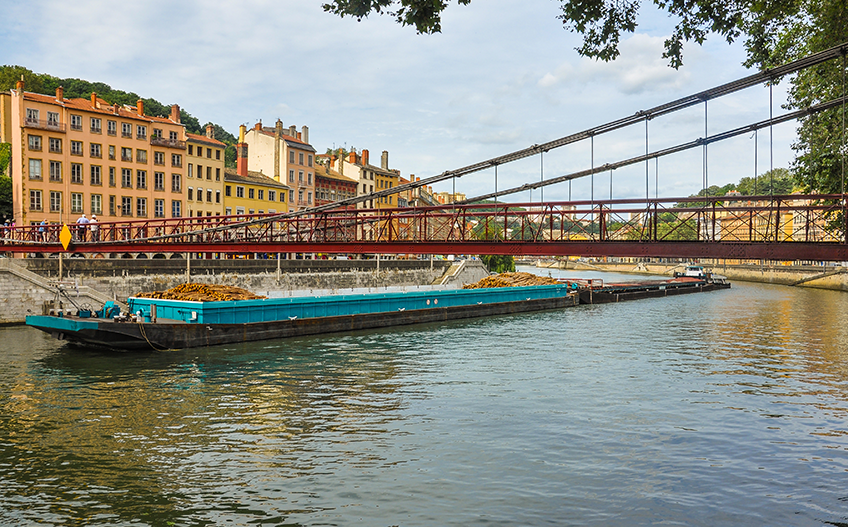River and Lake transportation
Freight transport on the Saône
In the current context of global warming and ecological transition, the development of river and lake transport appears to be a relevant technical solution in view of its low energy consumption per ton or passenger transported. While France has an extensive river network, the largest in Europe, large seaports and large navigable lakes, it appears that this mode, despite the context of expanding sustainable development, remains underutilized.

River freight transport, which faced competition from rail transport at the beginning of the 20th century, is a clean solution, running on an uncongested infrastructure, reliable and capable of delivering large volumes both on major routes and close to city centers.
However, river distribution has many advantages:
- Reducing of environmental nuisances
- Reducing traffic congestion and easy access to city centers
- Optimization of inventory management
- Securing delivery times
Some precursory economic actors have been reusing the Seine for several years in Paris but also in other large French and European cities: Lille, Lyon, Strasbourg, Utrecht in the Netherlands…
Despite all these advantages, the economic choice of river transport is still insufficiently profitable because of the obsolescence of certain parts of the network and the lack of interconnections within the network and with other transport modes.
River and lake transport of people, complementary to bus or tramway solutions, as on the Garonne in Bordeaux or on Lake Leman where shuttles allow direct and rapid travel between two banks, facilitates the daily life of the inhabitants of many European territories. River shuttles and, by extension, maritime shuttles, but also lake shuttles, can constitute a real public transport service in their own right in geographically constrained areas with a congested road network. They can be integrated into local networks in terms of schedules, ticketing, fares and the location of the ports of embarkation, which can be interconnected with other modes.
In order to gain in competitiveness and attractiveness, the inland waterway transport sector must highlight its main asset, energy sobriety, and strengthen it through an action towards energy transition involving a strong commitment to greening the fleet’s engines.
Energy transition
With the acceleration of global warming, river and lake transport must be one of the levers for the future of the indispensable ecological and energy transition. Because of its environmental footprint, which is much smaller than that of road transport due to the massification that it allows, this mode significantly meets the requirements of reducing carbon emissions and atmospheric pollutants, for transporting people and goods of all kinds.
However, the challenge for the years to come is to make river and lake transport even cleaner.
This mode of transport offers enormous ecological advantages: a ship that transports the equivalent of up to two hundred trucks in a single trip consumes three to four times less energy, and therefore emits three to five times less CO2 than the same transport by truck, for example. However, it does not escape an objective examination of its environmental performance. Indeed, the boats are sometimes quite old and the engines have a long service life. Thus, river and lake transport must adapt to new environmental standards, or even anticipate them, in order to maintain its natural competitive advantage.
Boats are special vehicles: they are not exactly sea-going vessels, on which pollution control solutions have been being deployed for several years, nor are they trucks or other land transport vehicles, which are now subject to the “Euro VI” standard. River and lake vessels have very specific characteristics, particularly in relation to “navigation in confined environments”. Designing and marketing new engines or exhaust systems therefore requires a major Research & Development (R&D) effort.
Unfortunately, the supply of river and lake transport opens up poor prospects for cushioning an R&D effort, with about one thousand French registered freight boats in 2018, and about six hundred professional boats in river tourism, pooling R&D efforts with other vehicle sectors is imperative.

A real need for innovation in the river sector
In order to fully commit to green growth in river and lake transport, it is now necessary to offer transporters operational and inexpensive solutions to enable them to upgrade their vessels to cleaner engines than in the past. To do this, Voies Navigables de France and its partners, including CARA, are trying to transpose to the river sector solutions that already exist in other modes of transport: “marinizing” road engines that comply with the Euro VI standard, implementing solutions based on hydrogen or natural gas (compressed or liquefied), etc.




